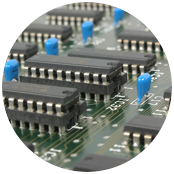Ceramic capacitors have ceramic as the dielectric (insulating) material used between the plates of the capacitors in their manufacturing process. Ceramic is used for its ability to permit electrostatic attraction and repulsion to take place across it. Ceramic is an excellent dielectric material because it is a poor conductor of electricity while being an effective supporter of electrostatic fields.
Ceramic capacitors are manufactured using a tape-casting process wherein thin layers of conductive electrodes are separated by a dielectric layer, and a kind of multilayer "sandwich" is formed to create a ceramic capacitor with a very large surface area in a very compact size. Recently, the combination of nickel electrodes and the ability to cast very thin layers has allowed the capacitance range of ceramic capacitors to exceed more than 100μF in an 1812 package, using X5R dielectric material. With the ability to stack hundreds of layers to form a single high-density, high-capacitance multilayer ceramic capacitor, new application opportunities—previously the sole domain of tantalum capacitors—are now available for ceramic capacitors.
Prior to the use of nickel electrode systems, palladium (Pd) and silver (Ag) were the most common electrode materials. This precious metal became cost prohibitive when making high-capacitance, high-layer-count ceramic capacitors. Palladium and silver are still widely used for ceramic capacitors with lower capacitance values.
There are now a number of ceramic materials and compositions that are used in ceramic capacitors, including ceramic COG (NPO), ceramic X5R, and ceramic Y5V. COG (NPO) is a high-Q, low-K, temperature-compensating type of dielectric with stable electrical properties across varying voltage, frequency, and time. It is suitable for circuits that require low loss, as well as in timing and tuning applications. NPO ceramic capacitors offer the best capacitance precision.
The X5R dielectric has moderate K values and stable temperature. It shows moderate change in electrical properties across changing temperature, voltage, and frequency. It is suitable for bypassing, coupling, and frequency-discrimination circuit applications. X5R ceramic capacitors show no more than a 15% capacitance deviation over the temperature range -55°C to +85°C.
The Y5V dielectric is a Class III dielectric that exhibits a maximum capacitance change of +22%, -82% over an operating temperature range of +30°C to +85°C.
Disc ceramic capacitors combine a solid body of high-temperature, ceramic-resistive material with bonded metal contacts. Multilayer disc ceramic capacitors are constructed using an alternating stack of conductors and insulators, connected on both sides by a common termination. The standard termination material for ceramic capacitors is nickel barrier with a 100% tin coating to comply with the latest RoHS standards. These ceramic capacitors are available in radial-leaded, conformal-coated packages or the more popular surface-mount configuration that is well suited for high-speed pick and place mounting.


